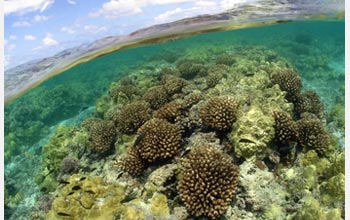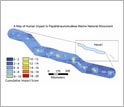News Release 09-060
Human Impacts on Coral Reefs of Northwestern Hawaiian Islands Revealed
New maps offer effective management tool

Coral reefs such as those pictured here in the Northwestern Hawaiian Islands are threatened.
April 6, 2009
This material is available primarily for archival purposes. Telephone numbers or other contact information may be out of date; please see current contact information at media contacts.
Results of a new study shed light on how threats to the world's endangered coral reef ecosystems can be more effectively managed.
In the current issue of the journal Coral Reefs, authors Kimberly Selkoe and Benjamin Halpern, both of the National Center for Ecological Analysis and Synthesis (NCEAS) at the University of California at Santa Barbara, explain how maps of the Northwestern Hawaiian Islands (NWHI)--a vast area stretching across more than 1,200 miles of Pacific Ocean--can be used to make informed decisions about protecting the world's fragile coral reefs.
"Our maps of cumulative human impacts are a powerful tool for synthesizing and visualizing the state of the oceans," said Selkoe, who is also affiliated with Hawaii Institute of Marine Biology at the University of Hawaii.
"The maps can aid in zoning uses of the oceans in an informed way that maximizes commercial and societal benefits, while minimizing further cumulative impact."
President George W. Bush declared the Northwestern Hawaiian Islands a National Monument in 2006, "in part because it is one of the last places in the oceans that have not been heavily altered by human activities," said Halpern.
"Despite the islands' extreme isolation, however, humans are already significantly impacting this area," he said. "Many of the key threats, such as those associated with climate change, are not mitigated with Monument designation."
The study was designed to help natural resource managers make decisions on issues such as surveillance priorities, granting of permits for use, and selection of areas to monitor for climate change effects.
"The Papahânaumokuâkea Marine National Monument is a crown jewel in the national and international array of marine protected areas, designed to preserve the ecosystems of these isolated islands," said Phillip Taylor of the National Science Foundation (NSF)'s Division of Ocean Sciences.
"This study is an important effort to assess and predict human effects on the oceans," Taylor said. "It shows how far-reaching human influences are, and will serve as a baseline in efforts to prevent and mitigate future harm."
The authors studied 14 threats specific to NWHI. The threats, all generated by humans, included invasive species, bottom fishing, lobster trap fishing, ship-based pollution, ship strike risks, marine debris, research diving, research equipment installation and wildlife sacrifice for research.
Human-induced climate change threats were also studied, including increased ultraviolet radiation, ocean acidification, ocean temperature anomalies relevant to disease outbreaks and coral bleaching, and sea level rise.
Increased rates of coral disease due to warming ocean temperatures were found to have the highest impact, along with other climate-related threats.
"With the scientific justification provided by our study, the managers of the Monument have an opportunity to make addressing the worst threats a top priority," said Selkoe.
"By updating the map of cumulative impacts through time, success of management plans in reducing impacts can be measured, and permits for new uses can be evaluated in the context of how they add to these impacts."
The authors note that this analysis can serve as a case study for other areas and managers interested in mapping region-specific cumulative human impacts.
NCEAS is supported by NSF's Division of Environmental Biology. This research was also funded by the National Oceanic and Atmospheric Administration.
-NSF-
-
A map of the Northwestern Hawaiian Islands shows human impacts on coral reefs there.
Credit and Larger Version
Media Contacts
Cheryl Dybas, NSF, (703) 292-7734, email: cdybas@nsf.gov
Gail Gallessich, UCSB, (805) 893-7220, email: gail.g@ia.ucsb.edu
The U.S. National Science Foundation propels the nation forward by advancing fundamental research in all fields of science and engineering. NSF supports research and people by providing facilities, instruments and funding to support their ingenuity and sustain the U.S. as a global leader in research and innovation. With a fiscal year 2023 budget of $9.5 billion, NSF funds reach all 50 states through grants to nearly 2,000 colleges, universities and institutions. Each year, NSF receives more than 40,000 competitive proposals and makes about 11,000 new awards. Those awards include support for cooperative research with industry, Arctic and Antarctic research and operations, and U.S. participation in international scientific efforts.
Connect with us online
NSF website: nsf.gov
NSF News: nsf.gov/news
For News Media: nsf.gov/news/newsroom
Statistics: nsf.gov/statistics/
Awards database: nsf.gov/awardsearch/
Follow us on social
Twitter: twitter.com/NSF
Facebook: facebook.com/US.NSF
Instagram: instagram.com/nsfgov



